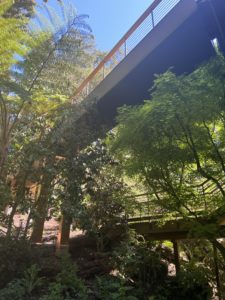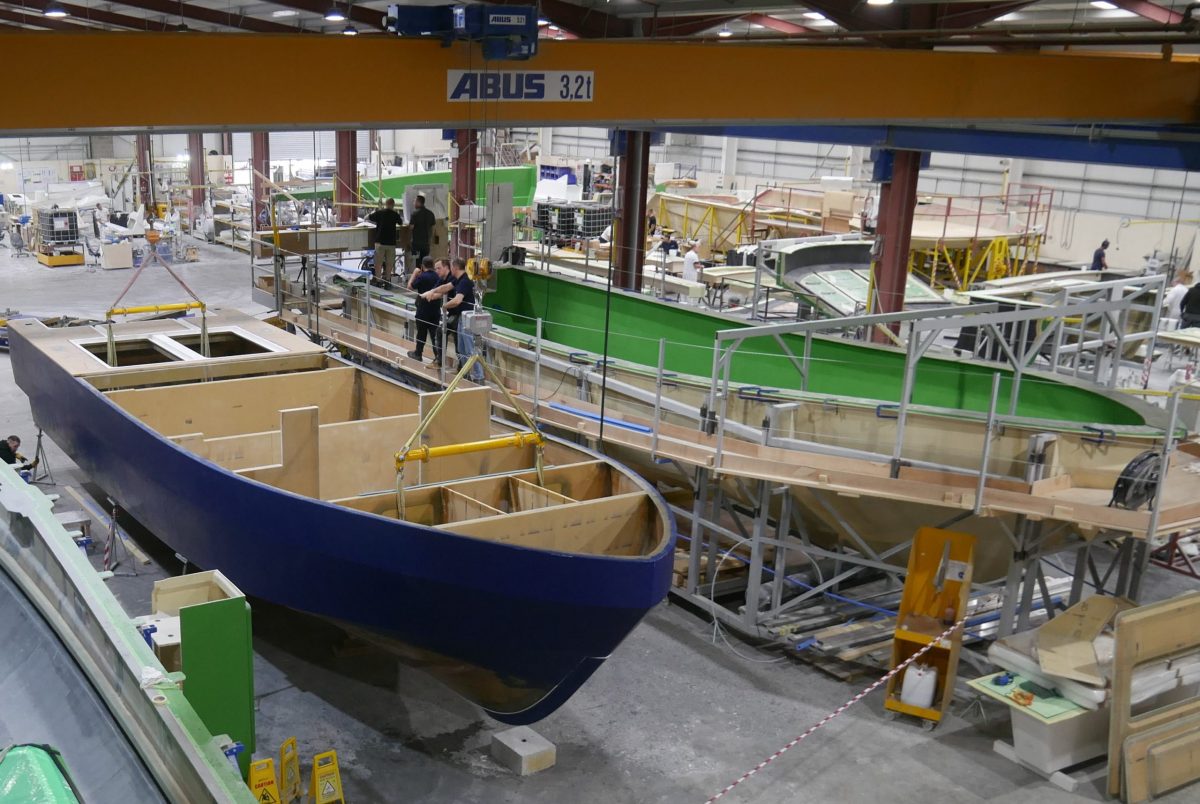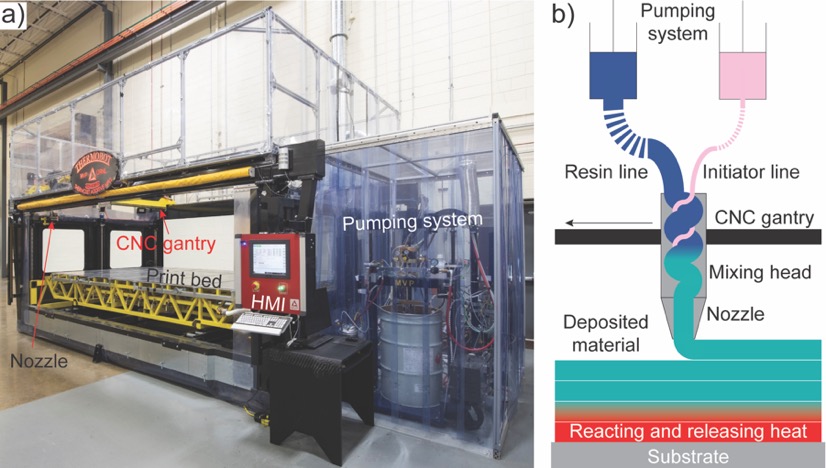
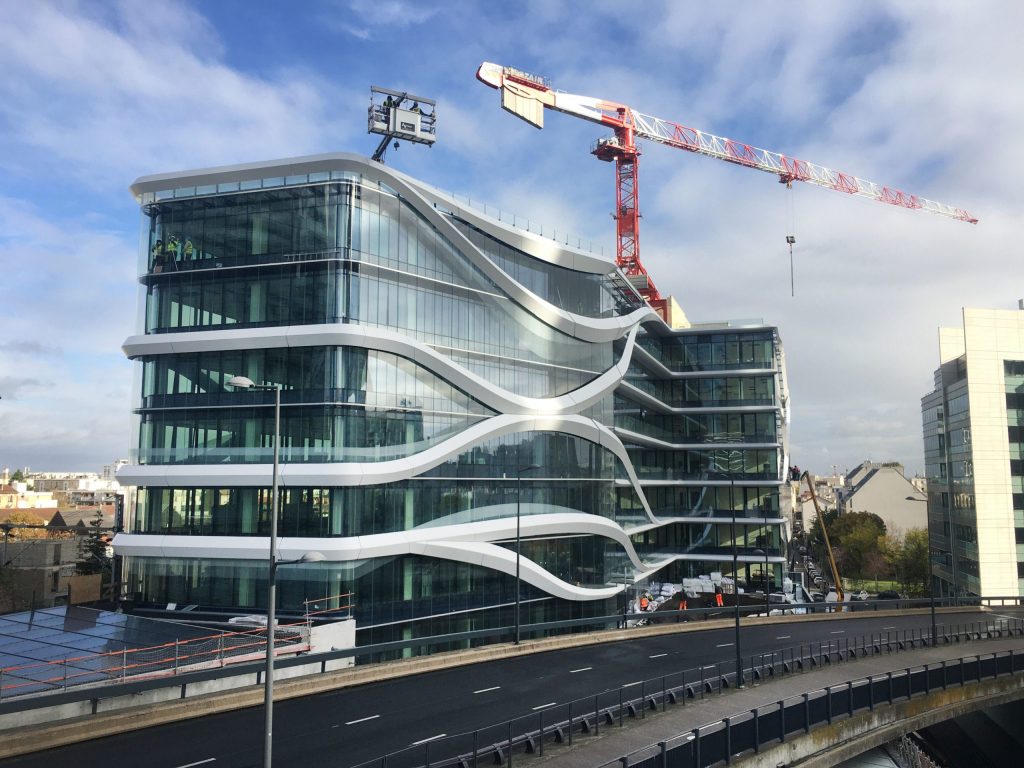
Eye-Catching Architecture
Figuring out the best way to construct an architect’s design can be challenging for contractors, who may be limited by traditional building materials like concrete, steel and wood. In recent years, however, some architects and builders have turned to composite materials to remove constraints. The light weight and flexibility of composites can make FRP the material of choice for stand-out design features.
These four projects showcase the benefits and possibilities that composites can offer the building industry.
Project: The Latitude office building
Location: Paris
Composite Component: GFRP façade
Tasked with renovating and adding space to a 1970s-era office building, Studio Architecture designed a striking façade of curved ribbons that connect the original, newly glazed section and a new wing of the Latitude building in Paris. Construction was challenging for general contractor Bouygues Bâtiment Ile-de-France.
“Originally, the ribbon shapes were going to be made using thermal forming of thermoplastic plates with a steel structure inside,” says Samuel Durand, senior structural engineer and manager at the engineering/design firm Meca. However, the steel/thermoplastic ribbons would be too heavy, and Bouygues could not find a subcontractor capable of meeting the architect’s visual standards.
So, Bouygues worked with Meca and specialty chemical supplier Sika on a composite solution. Sika suggested blocks of freestanding polyurethane foam for the triangular ribbon shapes, using a heavier density of the material for longer spans. It joined the blocks with a fast-curing polyurethane resin, then had a subcontractor machine the lengths into individual ribbon shapes.
Next, subcontractors Le Prince Borel and SMM Technologies covered the tops and sides of the blocks with fiberglass fabric impregnated with an epoxy resin, SikaBiresin® CR82. It cured the ribbons at room temperature and then post-cured them at 50 to 55 C.
For the ribbon undercovers, Armacell supplied PET foam boards, which Sika sandwiched between two layers of fiberglass fabric and infused with SikaBiresin CR80 epoxy resin.
Finding a material that was easy to work with, durable and color-consistent to withstand long-term weather exposure was a challenge, says Patrick Noirclerc, composite products engineer at Sika. Since manufacturing consistency was another concern, Sika performed Meca-developed testing on a mock-up ribbon section, measuring properties such as tensile strength, thermal expansion, fatigue and mechanical junction strength.
Composites provided a cost-effective solution that gave the architects freedom of design.
“Glass reinforced concrete, or any other type of more conventional building material, would not allow this type of curves,” says Henri Chapelle, sales and marketing manager, PET foams, Armacell.
Project: David Geffen Hall, Lincoln Center for the Performing Arts
Location: New York
Composite Components: GFRP ceiling panels
Improving the acoustics of the Wu Tsai Theater was a primary goal in the renovation of Lincoln Center’s David Geffen Hall. Kreysler & Associates created the textured GFRP ceiling panels that helped achieve the desired sound.
Composites have become a favored material in performance spaces because they are configurable to acousticians’ detailed specifications. “Acousticians don’t like smooth, flat surfaces, because the sound bounces off of them in ways that can create echoes,” says Bill Kreysler, the company’s founder and CEO. “For most of the acoustical panels that we’ve done, the design calls for a pattern – a texture on the surface. The texture can be very organic, or it can be a very specific geometric pattern that creates a kind of three-dimensional relief surface, in addition to the panel itself being curved.”
For Wu Tsai Theater, architect Diamond Schmitt and acoustician Akustiks wanted the ceiling to resemble the space’s new perforated metal wall panels. Akustiks also specified that the panels had to weigh precisely five pounds per square foot.
“We were very involved in the surface pattern geometry to help the architect achieve what they wanted within the schedule,” Kreysler says. “Some molds took several hundred hours of CNC milling, so the mold milling time determined the schedule of the product.” The company added a proprietary concrete to the backs of the panels before removing them from the mold to achieve the desired weight.
Kreysler produced 40 GFRP panels using an open molded hand lay-up method. The panels varied in size from 4.5 x 8 feet to 20 x 10 feet. The total surface area is 4,200 square feet.
The panels were bolted to a frame that can be rotated to fine tune sound for different performances. That required careful engineering of the connections, which were embedded during molding.
“Since the panels need to rotate 90 degrees from time to time – and to be lowered and raised – and since there are several penetrations where light and rigging comes through, the engineering of the panel was fairly complex,” says Kreysler.
Geffen Hall’s official opening was scheduled for late October 2022. Preliminary tests of the theater’s acoustics won positive reviews from musicians and audience members.
Project: The Heritage luxury apartment
Location: São Paolo
Composite Components: GFRP exterior ornamentation
Pininfarina, an Italian firm known for car design, has branched out into architectural design. One recent project, the Heritage luxury apartment building in São Paolo, features dynamic, curved GFRP accents on the building’s 32 floors.
Project developer Cyrela asked the design/engineering firm Clamom to determine the best way to build the composite overlays for the balcony bottoms and 16 J-shaped forms that create a visual link between every other floor. Concrete would have required additional structural support, and aluminum composite materials would have required too many pieces, making it difficult to achieve the continuous, flowing lines that Cyrela wanted.
So, Clamom contacted Gatron, a composite manufacturer with experience in wind power, transportation, agriculture and other industries.
“The challenge was to be able to manufacture a piece with a sinuous design that was, at the same time, lightweight, weather resistant, with high dimensional stability, a minimum number of amendments [connections] and perfectly aligned to the balconies,” says Jean Zolet, executive director at Gatron. The maximum tolerance gap was 2 millimeters.
“Cyrela sent us the 3D drawings, and we worked together with them to adjust the drawings so that it was possible to produce the composite parts,” he adds. Gatron manufactured 47 molds to manufacture the balcony covers and the J-shape forms – each with a distinct geometry – using chopped strand fiberglass mats and a resin that met the required flammability standards. The forms were made using an infusion molding process.
The company produced 755 pieces, all with an automotive Class A finish. The largest piece was approximately 19.6 feet long, 1 foot wide and 13 feet high. The other pieces averaged 26.2 x 1.6 x 1.8 feet. Gatron produced an average of 20 pieces per day, which were then attached to the building using a special metallic fastening system that was embedded in the composite during molding.
Zolet says everyone involved in the project was pleased with the aesthetics and the performance of the composite components.
“We understand that the success of this project will bring new business, and we continue to work hard to close new business in this market,” he says. “We believe that in the next five years we will see a significant increase in the architectural market.”
Project: Residential home
Location: Berkeley Hills, Calif.
Composite components: CFRP pedestrian bridge
A homeowner in northern California had a seemingly simple request: He wanted a walkway from the house’s back deck to the garage. But a deep gully stood between the two. Since there was no simple way to employ heavy construction equipment in the residential neighborhood, the walkway’s components had to be lightweight enough to be carried through the house by the installation crew. A CFRP bridge was the solution.
Kreysler & Associates built the 50-foot-long pedestrian bridge in three sections, using a hand lay-up, open molding process. The railings are CFRP tubes. The bridge has an unusual support system.
“You would think that a bridge would be supported at each end, and maybe in the middle,” Kreysler says. “But in this case, because one end of the bridge abuts the deck of the house, the engineers didn't want to connect it because of the potential for movement during an earthquake.” The solution was to anchor the bridge at the garage end, support it in the middle with a steel-reinforced concrete column and then simply abut it to the house.
“From the middle all the way to the house it was a cantilever; there was no connection. It’s almost like a giant diving board,” says Kreysler.
Thanks to the newly installed bridge, the homeowner now has a quick route to the garage. But Kreysler admits that CFRP materials are rarely used in construction projects. Architects generally don’t need the additional strength and light weight that carbon fiber provides, so they are not willing to pay the premium except in specialized cases like this one.
Photo Credit: Kreysler & Associates
Bringing Composites to the Construction Forefront
Bill Kreysler, founder and CEO of Kreysler & Associates, has spent decades advocating for the adoption of advanced composites by the architectural, engineering and construction (AEC) community. There’s been encouraging progress, but the composites industry is still battling the community’s resistance to change.
Kreysler says this reluctance to try new methods and materials has resulted in construction’s decrease in productivity over the last 40 years. Conventional material suppliers want to maintain the status quo, and contractors are hesitant to work with composites, a material unknown to them, since they must guarantee a building’s performance over time.
Composite materials guidelines have been included in building codes for more than 10 years, but many engineers, uncertain about their performance, require additional testing before they approve its use. Kreysler has built many exterior components and paid for testing them. However, the design of sunshade hoods for 633 Folsom, an office building in San Francisco, was so unusual that the engineer required additional, expensive flammability testing. Such added costs can be problematic for tight construction budgets.
The good news is that attitudes are changing. As composites repeatedly demonstrate their ability to meet codes and design requirements, the push for further testing should decrease. In addition, the wider use of prefabricated modular building has encouraged the use of innovative techniques and materials like composites.
One continuing challenge is the higher initial cost of composite materials. But architects and engineers are beginning to understand the advantages of their light weight.
“If you could do with two pounds of plastic or FRP what you would otherwise need 30 pounds of concrete to do, that’s a big advantage,” Kreysler says. For the San Francisco Museum of Modern Art’s façade, for example, engineers eliminated more than a million pounds of support steel by using GFRP rather than glass reinforced concrete.
Architects will also come to appreciate the design freedom that only composite materials can provide. “Every new big project is a door opener for the next one,” says Patrick Noirclerc, a composite products engineer at Sika.
Incorporating FRP materials into smaller-scale, everyday buildings will help composites gain acceptance as well. Kreysler & Associates provided FRP library exterior façade panels for a junior college library. “It wasn’t super exotic, but with FRP they gave themselves something a little special,” he says.
Projects like this will also show the construction community what composites can do.
“This material is amazing, and it’s lighter than anything else you can use,” says Kreysler. “And, if your building has some repetition to it, it can be cost-effective, too.”
Mary Lou Jay is a freelance writer based in Timonium, Md. Email comments to mljay@comcast.net.
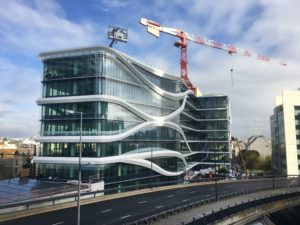
The Latitude office building in Paris features a facade of GFRP ribbons totaling 547 yards long.
Photo Credit: ©Nicholas Grosmond
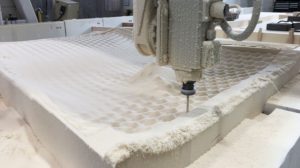
It took hundreds of hours of CNC milling to produce the intricate molds for the ceiling panels in the Wu Tsai Theater in the Lincoln Center’s David Geffen Hall.
Photo credit: Diamond Schmitt
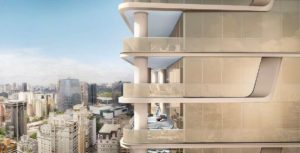
The Heritage luxury apartment building in Sao Paolo incorporates J-shaped composite frames.
Photo Credit: Gatron
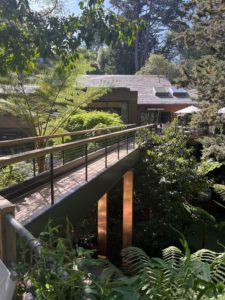
This 50-foot-long CFRP residential bridge traverses a gully between the home’s deck and garage.
Photo Credit: Kreysler & Associates

SUBSCRIBE TO CM MAGAZINE
Composites Manufacturing Magazine is the official publication of the American Composites Manufacturers Association. Subscribe to get a free annual subscription to Composites Manufacturing Magazine and receive composites industry insights you can’t get anywhere else.


